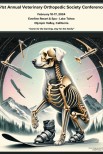Dog Sheltie 8 Years of age Female intact Reported trauma the day before during chasing a cat Acute onset of neck pain and hemiparesis the follwing day Radiograph of the neck was taken Radiographic examination Left lateral view of the neck Radiographic findings There is a mild malalignment of C1-C2 with subjective increased distance between the cranial spinous process of the axis and the arch of the atlas (arrow). There is a small step formation in the mid body of the axis, ventrally (open arrow) and within the spinal canal (arrowhead). Radiographic diagnosis Close up of the lateral view of the cervical region. Radiographic diagnosis The diagnosis was fracture and luxation of C2. To better invastigate the nature of the fracture and to plan the appropriate surgery, the dog underwent a CT examination. Multiplanar reconstruction, bone algorithm of the cervical cranial spine (upper left sagittal plane, lower left transverse plane): The step formation with dorsal luxation of the caudal part of C2 is more obvious (arrow). Additional rotation is visible on the transverse plane. 3D reconstruction (image on the right): Again better visibility of the malalignment at the level of the fracture. On the soft tissue algorithm, a hyperintese region in the spinal cord was visible (not shown), interpred as focal bleeding. The dog underwent surgery. The fracture was fixed as shown in the post OP radiographs. Left lateral (on the left) and VD view (on the right) of the cervical spine post OP Comments
- It has been reported that cervical vertebral fractures involves the C1-2 spinal unit in about 80% of the cases.
- It has been theorized that this portion of the spine is especially susceptible to seriuous injury owing to the relative articular rigidity of this region compared with that of the caudal portion of the cervical region.
- Kinns et al. reported (Vet Rad and US, 2006) a moderate sensitivity of radiographic examination for diagnosis of vertebral fractures (72%) and subluxation (77.5%).
- Crucial is the diagnosis of instable fractures because sedation can release the muscular bracing that protects the spine from additional damages and positioning of the patient for the radiographic, CT or MRI examination should be extremely careful.









